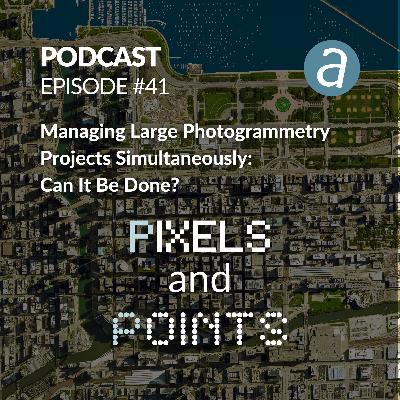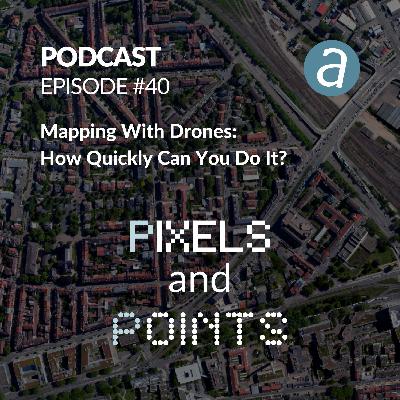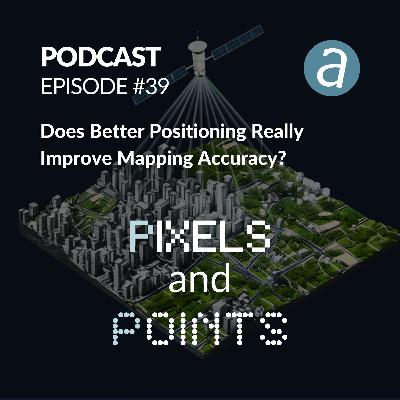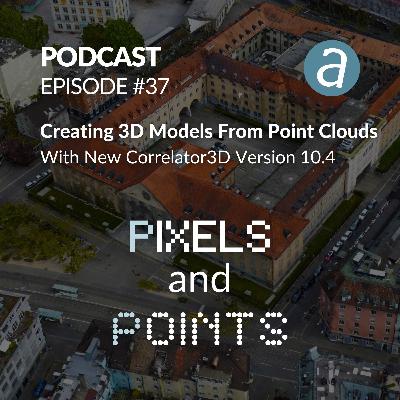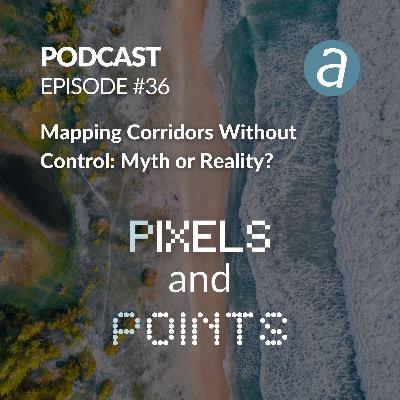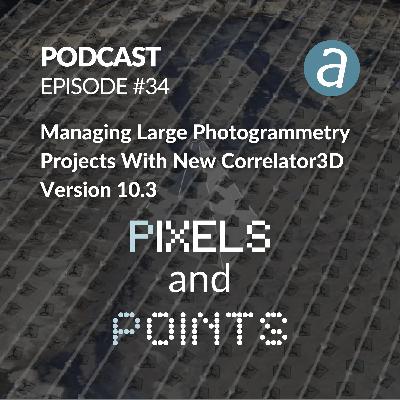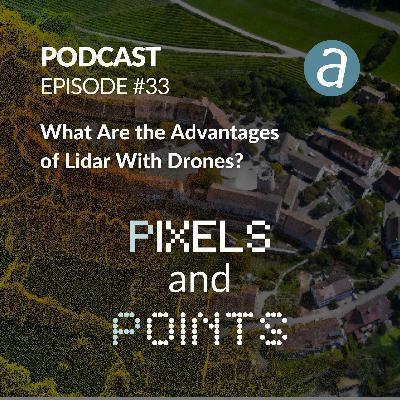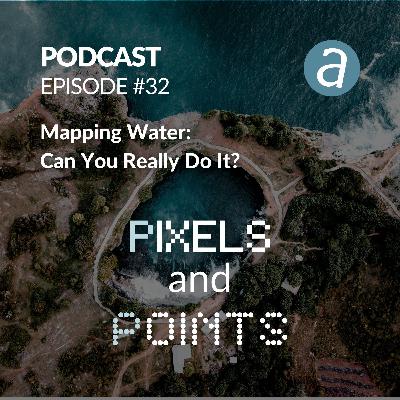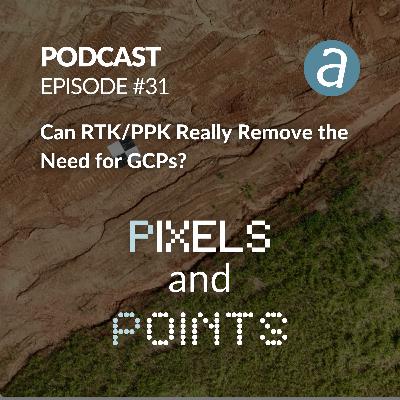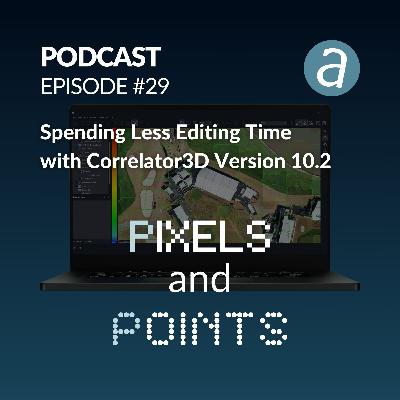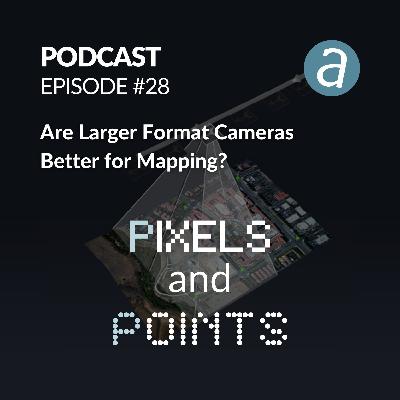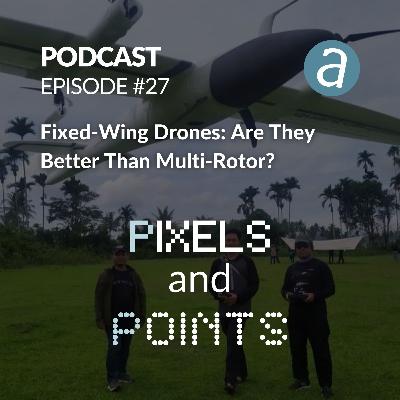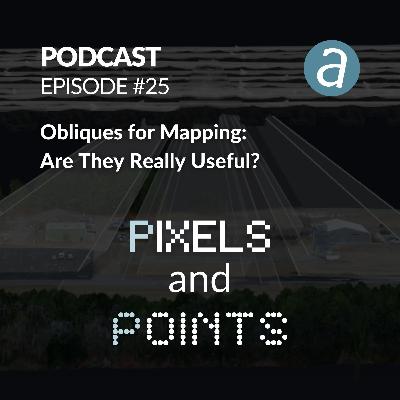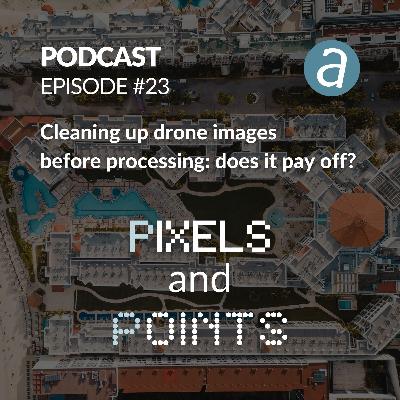Discover Pixels and Points
Pixels and Points

Pixels and Points
Author: SimActive
Subscribed: 4Played: 49Subscribe
Share
© SimActive
Description
Pixels and Points is an original podcast produced by SimActive. Through the different episodes, discover the world of photogrammetry and mapping from drones, aircrafts and satellites.
To learn more about SimActive, visit our website www.simactive.com and follow us on our social media.
Enjoy the show!
To learn more about SimActive, visit our website www.simactive.com and follow us on our social media.
Enjoy the show!
42 Episodes
Reverse
Hosted by Michael O'Sullivan, VP Sales at SimActive. With guest speaker Stefan Löser, Product Specialist, geo-konzept GmbH.Drone photogrammetry enables generating 3D point clouds to perform volumetric calculations. For example, it is changing the way mining sites operate, making processes faster, safer, and more data-driven. Join our guest Stefan Löser from geo‑konzept as he explores how photogrammetric technologies are helping to improve accuracy, safety, and productivity. Gain insights into how practical workflows can be tailored for 3D measurements.Specifically listeners will learn the following:• Choosing the right drone• Setting up frequent data collections for real-time operational awareness• Generating point clouds for detailed terrain analysis and planning• Performing volume calculations to optimize ground operations
Hosted by Michael O'Sullivan, VP Sales at SimActive. with guest speaker, Pradipta Mahapatra, Founding Member and Delivery Manager at Impulsions LaserCurious how production shops handle several projects at once? Join our guest speaker, Pradipta Mahapatra at Impulsions Laser, as he shares proven strategies for delivering geospatial data to multiple clients efficiently. Learn practical techniques to streamline photogrammetric workflows and ensure quality results.Specifically listeners will learn the following:- Understanding input data- Creating a scalable workflow- Processing large image datasets- Ensuring high-quality outputs
Hosted by David Alamillo, Photogrammetry Specialist at SimActive with guest speakers Mark Bickel, UAV Department Manager at SurvTech Solutions and Marcos Bayuelo, SVP Product & Growth at Wingtra.Explore the power of rapid drone mapping in this podcast session, featuring expert insights from Survtech, Wingtra and SimActive. Discover how to optimize your workflow to produce high-quality map products like elevation models and orthomosaics in record time. This session will offer practical tips for drone operators to enhance efficiency and achieve professional results with ease.Specifically, listeners will learn about the following: • Choosing the right tools for mapping • Planning effective data acquisition• Streamlining processing for fast turnaround • Mastering photogrammetry best practices
Hosted by Eric Andelin CP, Senior Workflow Advisor at SimActive. With guest speaker, Mohamed M. R. Mustafa, Lead Technical Authority - Mobile Mapping at Trimble Applanix. High-accuracy positioning systems, such as those developed by Applanix, are crucial for ensuring the quality of large-scale mapping projects utilizing new sensors and multi-sensor systems. When integrated into the aerial triangulation process, these systems assist photogrammetry software such as Correlator3D in generating high-quality map products like digital elevation models, orthomosaics, and 3D models.Dr. Mohammed Mostafa, a technology expert in positioning systems, understands the complexities of integration with multiple sensor systems for mapping and 3D model creation. These positioning systems also offer a direct georeferencing option when a targeting approach using ground control is not a viable option. Dr. Mostafa joins us to share his expertise in these technologies and how Correlator3D enables optimal outcomes.Specifically listeners will learn the following: • Choosing the right positioning systems• Understanding their integration with sensors• Importing positional data into Correlator3D • Quantifying achievable accuracies
Hosted by Eric Andelin CP, Senior Workflow Advisor, SimActive with Guest David Alamillo, Photogrammetry Specialist with SimActive. The two primary technologies for mapping are photogrammetry and lidar. While lidar mapping is the newer of the two, does it necessarily mean it is better? The complexity of lidar lies in all the ancillary technology required to create a viable output, whereas photogrammetry needs no additional technology remaining the simpler of the two. This prompts the question of whether established technologies like photogrammetry remain a practical solution for many mapping scenarios.Specifically, listeners will learn the following: • Choosing the right sensor• Preparing the project for processing• Measuring accuracy • Merging technologies to improve results
Hosted by Eric Andelin CP, Senior Workflow Advisor, SimActive with guest speaker, Alamillo, Photogrammetry Specialist, SimActivePodcast AnnouncementWith the rise of multi-camera sensors capturing both nadir and oblique imagery, 3D models are becoming a more accessible output. The ability to collect data with multiple looks at the ground allows for the creation of very dense point clouds. These point clouds can then be used as a basis to create 3D models having the form of texturized meshes. Correlator3D version 10.4 adds improved 3D modeling capabilities and was designed to be compatible with future modeling industry improvements. Input data consists of imagery along with point clouds generated from either photogrammetry or lidar. This gives the user more flexibility from the start and potential time savings in processing. Guest David Alamillo joins us to discuss the best practices when creating 3D models in Correlator3D. Specifically, listeners will learn the following: • Understanding the optimal sensors for 3D modeling• Generating the best point cloud possible from imagery• Performing triangulation to generate a texturized mesh• Using lidar point clouds for modeling rather than photogrammetry
Hosted by Eric Andelin CP, Senior Workflow Advisor, SimActive with guest speaker, Joseph “Heath” Harwood, Physical Scientist, US Army Corps of Engineers, Mobile DistrictTopicThe U.S. Army Corps of Engineers rely on the research of the JALBTCX team to support their coastal mapping and charting needs. From Hawaii to Florida, shorelines are constantly changing. Lidar, bathymetric lidar and imagery all play an important role in this program. And when imagery is part of a mission, Correlator3D is called into action. Heath Harwood of JALBTCX leads a team of employees and contractors in supporting these missions. He is aware of the challenges involved with large corridor mapping projects. Not only is terrain variation an issue, but on projects of this scale, ground control is not an option. Rather, they rely on direct georeferencing. Heath joins us to give us an overview of the program and how these challenges are overcome with Correlator3D. Specifically, listeners will learn about the following: • Planning for successful corridor mapping• Setting up a project with direct georeferencing• Understanding achievable accuracies• Editing surfaces and mosaics to improve results
Hosted by Eric Andelin CP, Senior Workflow Advisor, SimActive with guest speaker, Dr. Mohsen Miri, Director of Global Strategic Partnerships, Phase OneAerial cameras and photogrammetry are proven mapping solutions on both drones and aircraft. Phase One offers a range of imaging sensors to support each of these platforms. Along with this, they have developed an image compression technology called IIQ to support the large amounts of data being captured. Processing such large files and datasets can be challenging and workflows can be simplified by taking advantage of the IIQ format. Dr. Mohsen Miri, Director of Global Strategic Partnerships, with Phase One, joins our host Eric Andelin to discuss camera technology and image processing workflows to meet today’s mapping needs. Specifically, listeners will learn the following: • Determining your project requirements• Choosing the right imaging sensor• Understanding the impact of sensor size on processing• Simplifying your processing workflow
Hosted by Eric Andelin CP, Senior Workflow Advisor, SimActive with guest speaker David Alamillo Photogrammetry Specialist with SimActive.
Podcast Announcement
Eric and David, two photogrammetry experts, will discuss the features and benefits of new Correlator3D Version 10.3. This release reflects a lot of work under the hood, specifically to optimize interactions with data when working with large datasets. As users continue to push these limits, our development team keeps enhancing performance and user experience with the software. Version 10.3 provides many improvements because of feedback from users working on very large projects.
Specifically, listeners will learn the following:
• Preparing to process large projects
• Best practices for success
• Speeding up processing with multiple PCs
• New features of version 10.3
Hosted by Eric Andelin CP, Senior Workflow Advisor, SimActive with guest speaker Maude Pelletier, President and CEO of Balko Technologies
Weight, cost, and complexity have always been large hurdles for those wishing to employ lidar with drones. As manufacturers have worked diligently to solve the first two, bringing all the components together to produce a high-quality point cloud can still be challenging. However, where there is dense vegetation lidar does a very good job of penetrating tree canopy to reveal ground points. Whereas photogrammetry is inherently easier for the user to interpret as it is based on imagery rather than just points. While each works as standalone solution, there are also many benefits to a hybrid option using both. Maude Pelletier, President and CEO of Balko Technologies, joins us to discuss the future of lidar and hybrid solutions.
Listeners will learn the following:
• Understanding the benefits of lidar and imagery
• Selecting the proper hardware configuration
• Planning for dual acquisition
• Merging lidar and photogrammetry in C3D
Hosted by Eric Andelin CP, Senior Workflow Advisor, SimActive with guest speaker Austin Scheib, Certified UAS Pilot.
Mapping areas with water through photogrammetry can be a challenge. Sun reflections and homogeneity between images can really make the process difficult. Resulting DSMs/DTMs can often be noisy, while orthomosaics may present color issues. To mitigate this, additional tie points can be used while performing aerial triangulation, or existing polygons of water bodies can be applied with fixed elevation values. Moreover, seamline editing can be done to create the best possible orthomosaic by choosing images or areas within images where little glare can be found. Austin Scheib joins us to discuss some of the challenges he has faced, and best practices involved in mapping around water.
Specifically, listeners will learn the following:
• Considerations before flight
• Options for successful aerial triangulation
• Ways to fix DSMs/DTMs
• Solutions to ensure the quality of mosaics
Hosted by Eric Andelin CP, Senior Workflow Advisor, SimActive with guest speaker Chris Greene UAS Manager with Bullseye Construction.
Drones used for mapping require much more than a capable pilot, drone, and photogrammetry software. To create map products, the resulting image data must be tied to the ground. And for this, some form of survey is required. Survey can be in the form of targets surveyed on, or in the air on the drone itself using RTK or PPK technology in conjunction with a receiver in the ground. In either case, the goal is to correct the position of the raw image data spatially so that it fits the same reference system on the ground. Chris Greene with Bullseye Construction joins us to discuss the challenges of new survey technology vs conventional methods.
Specifically, listeners will learn about the following:
Understanding RTK/PPK for drone
Supplementing with GCPs
Managing accuracy with Correlator3D
Confirming the quality of results
Hosted by Eric Andelin CP, Senior Workflow Advisor, SimActive, Inc., with guest speaker Gordon Morris, Owner of GMAPSNZ
With the relatively low costs involved in drone ownership, there has been an explosion in new mapping companies. As the value of drones for mapping begins to plateau on the hype curve, there is ample opportunity for those early adopters to share their knowledge helping others avoid the mistakes they may have made. This ranges from selecting the right drone for mapping to choosing the right processing software and tools for validation. Gordon Morris with GMAPSNZ in New Zealand joins us to discuss some of the pitfalls he’s seen and share his path to success.
Specifically, listeners will learn about the following:
Planning for what you’re mapping
Choosing the right drone for the mission
Developing processing workflows
Understanding options in Correlator3D
Hosted by Eric Andelin CP, Senior Workflow Advisor, SimActive with guest speaker David Alamillo, Photogrammetry Specialist with SimActive
Working with drones inherently means working with a large number of images, and as projects get larger, the amount of time spent editing outputs can increase exponentially. The same is true for traditional aerial mapping companies with large format cameras mapping even bigger projects. When creating mosaics, every input image will require a seamline within the overall mosaic,
leaving many seamlines to be inspected. In many cases, a cursory review is all that is needed to ensure the mosaic is color balanced with no visible conflicts between seamlines. However, in some cases, additional editing may be required to meet user specific requirements.
New Correlator3D version 10.2 incorporates a significantly more intuitive approach for seamline editing, making it easier and faster than before. The new version also includes new tools to manipulate point cloud data prior to export. Join us to learn more about these new tools and how they can save you time and money on your future mapping projects.
Listeners will learn the following:
· Streamlining mosaic editing
· Selecting specific ortho for inclusion
· Editing point clouds prior to export
· Performing quality control in real-time
Larger format cameras capture a larger footprint per image, and fewer images can certainly speed up the mapping process both in terms of acquisition and processing time. But does this make them better for mapping? Other factors that play a role in choosing cameras include lens quality, resolution, file size, and format.
As an example, the Phase One 280MP Aerial System offers a unique solution by merging two smaller format cameras to create a single larger format sensor. How are
these multi-camera systems treated when setting up projects for processing in photogrammetry software such as Correlator3D? David Alamillo joins host Eric Andelin to discuss these topics in depth.
Specifically, listeners will learn the following:
· Different camera formats & footprints
· Benefits of larger format sensors
· Effects on resolution and quality
· Considerations during processing to ensure success
Are multi-rotors dying a slow death in the traditional mapping space? As projects get bigger, it makes more sense to use fixed-wing drones as they cover more ground per mission. With the introduction of new payloads such as multi-camera systems and lidar, fixed wings are now capable of doing everything a multi-rotor can.
So if fixed-wings take over the traditional mapping space, are they a threat to aircraft? Not necessarily, as it depends on geographic location and access.
Yovist Taufan Founder and Director of Quantindo joins our host Eric Andelin to discuss how larger mapping projects create unique challenges.
Topics discussed include:
Advantages of fixed-wing drones over multi-rotor
Projects that benefit from fixed-wing
New fixed-wing payload options
Unique processing challenges
Hosted by Eric Andelin CP, Senior Workflow Advisor, SimActive with guest speaker, Krishn Pethani
Chief Technical Officer with Nektor Engineers and Project Consultants (NEPC).
Small to mid-sized mapping projects over terrain with little to no variation are easily tackled by drone operators. What happens when the project becomes much larger and is over hilly terrain? These types of missions can scare off even the most experienced drone operators.
NEPC is often mapping in the most challenging locations such as the Himalayas.
Krishn Pethani, Chief Technical Officer with NEPC, joins our host Eric Andelin to discuss how difficult mapping projects create unique challenges.
Specifically, listeners will learn about the following:
Choosing the right drone for a project
Considerations in planning missions over hilly terrains
Flying drones in difficult environments
Managing challenges with processing large datasets
Hosted by Eric Andelin CP, Senior Workflow Advisor with guest speaker David Alamillo, Photogrammetry Specialist, SimActive.
Until recently, photogrammetric mapping was performed with expensive aerial mapping cameras pointed directly towards the ground in what is known as nadir. However, when photogrammetric processing tools and aerial imagery moved into the digital environment, the need to constrain imagery to nadir became less of an issue when trying to create quality mapping deliverables. Add to this that the range of deliverables themselves has evolved to include 3D models.
It is true that oblique images may capture vertical structures, potentially enabling better texturization of features such as the sides of buildings. But are they useful for mapping? Is not one camera offset from nadir and the flight planned correctly sufficient to provide the same benefit as a multi-camera set up? Is nadir imagery not sufficient for mapping ? Is there really a value in 3D models as a mapping deliverable? David Alamillo, Photogrammetry Specialist with SimActive, joins our host to discuss oblique imagery for mapping, what it means and how it is processed in photogrammetry software such as Correlator3D.
Listeners will learn the following:
The difference between nadir and oblique imagery
Mapping vs 3D modeling
Considerations for successful oblique imagery acquisition
Processing options in Correlator3D
Host: Eric Andelin, Workflow Advisor at SimActive Inc.
Guest: Hayden Howard, Executive Vice President, CompassData Inc and Philipp Hummel Vice President, PLS, CFedS, CP at CompassData
Surveying and photogrammetry are complementary technologies. While either can be done without the other, they can both benefit from the use of the other. Aerial imagery and photogrammetry will always cover more ground than traditional ground-based survey. However, without ground-based survey, the absolute accuracy of a photogrammetry project cannot be defined. Photo identifiable ground control points (GCPs) are what allows the two technologies to come together. The positioning or physical location of GCPs and the quantity required for a project are all dependent on the accuracy desired, and the user’s confidence in supporting technologies. Hayden Howard and Philipp Hummel join our host Eric Andelin to discuss these topics.
Listeners learn the following:
• Why do placement and size of GCPs matter
• Why is distribution important
• How other technologies such as RTK/PPK play a role
• How many GCPs are required
Hosted by Eric Andelin CP, Senior Workflow Advisor, SimActive with guest speakers, Robert Leake, Head of Commercial Sales
and Nick Onelio, Growth Manager with Quantum Systems
Today’s drones are capturing more data because of their longer flight times and/or payloads that include multiple cameras. These capabilities magnify the need to cleanup and manage your data prior to and during import into your image processing
software. As the number of input images increase, processing time can escalate.
Robert Leake, and Nick Onelio join host Eric Andelin to discuss the value of project cleanup prior to processing and some simple steps to ensure processing success.
Listeners will learn about the following:
Validating exterior orientations and camera information
Identifying and removing unnecessary images
Choosing the right workflow for the project
Taking a hands-on approach to processing



